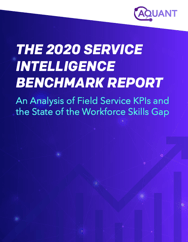The Skill Gap, Illustrated
Oct 26, 2020 • Features • White Paper • Digital Transformation • field service management • Aquant
This third excerpt from a recent white paper published by Aquant we see an interesting snapshot of the distance that exists between the highest and lowest performers on an organizational level and the consequences of an imbalance of knowledge within each service team.
Want to know more? Field Service News Subscribers can access a White Paper on this topic on the link below.
If you have yet to subscribe click the button below to join 30K of your field service management professional peers and subscribe now to access this content and our entire premium content library now!
 Data usage note: By accessing this content you consent to the contact details submitted when you registered as a subscriber to fieldservicenews.com to be shared with the listed sponsor of this premium content Aquant who may contact you for legitimate business reasons to discuss the content of this white paper, as per the terms and conditions of your subscription agreement which you opted into in line with GDPR regulations and is an ongoing condition of subscription.
Data usage note: By accessing this content you consent to the contact details submitted when you registered as a subscriber to fieldservicenews.com to be shared with the listed sponsor of this premium content Aquant who may contact you for legitimate business reasons to discuss the content of this white paper, as per the terms and conditions of your subscription agreement which you opted into in line with GDPR regulations and is an ongoing condition of subscription.
the team snapshot: the distance between heroes and challengers within an organization
First, let’s take a step back. Seasoned service leaders spend a lot of time looking at data dashboards to put the clues together. You may have scanned all the individual KPI stats above and thought to yourself, “Our organization is in pretty good shape. We fall well within the average.”
The problem? Those above KPIs are only telling part of the story.
A better way to think about the success of a service team is to understand how big of a skills gap exists between your best technicians and underperformers. That will help you hone in on underlying service issues.
To determine the skills gap we calculated the percentage difference between heroes and challengers across all organizations. We divided it into:
-
Top performing organizations
-
Average performing organizations
-
Poor performing organizations
Why The Skills Gap Matters:
A bigger distance between heroes and challengers leads to:
- Heavier workload on your already overburdened experts
- Increase in service costs
- Decrease in customer satisfaction
- Uptick in customer churn
- Less capacity for organizational resilience Negative impact on growth
DECREASE THE SKILLS GAP, INCREASE ROI
Advanced detective skills aren’t required to understand the benefits of a knowledgeable workforce.
Here is the cost savings associated with upskilling your workforce a little and a lot. 

Look out for the final feature in this series coming next week where we discuss the next steps to take now that you where and what to look in your service data.
However, www.fieldservicenews.com subscribers can read the full white paper now by hitting the button below. If you are yet to subscribe you can do so for free by hitting the button and you can access the white paper instantly upon completing the registration form!
Further Reading:
- Read more about Digital Transformation @ www.fieldservicenews.com/digital-transformation
- Read more about Aquant on Field Service News @ www.fieldservicenews.com/aquant
- Find out more about Aquant @ www.aquant.io
- Follow Aquant on Twitter @ twitter.com/Aquant_io






















 Field Service News is published by 1927 Media Ltd, an independent publisher whose sole focus is on the field service sector. As such our entire resources are focused on helping drive the field service sector forwards and aiming to best serve our industry through honest, incisive and innovative media coverage of the global field service sector.
Field Service News is published by 1927 Media Ltd, an independent publisher whose sole focus is on the field service sector. As such our entire resources are focused on helping drive the field service sector forwards and aiming to best serve our industry through honest, incisive and innovative media coverage of the global field service sector.
Leave a Reply